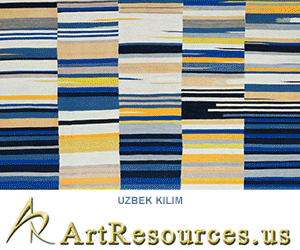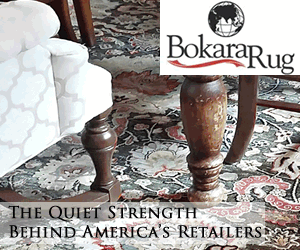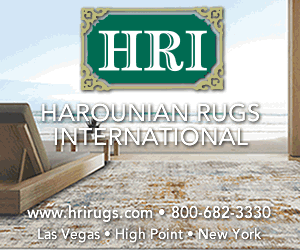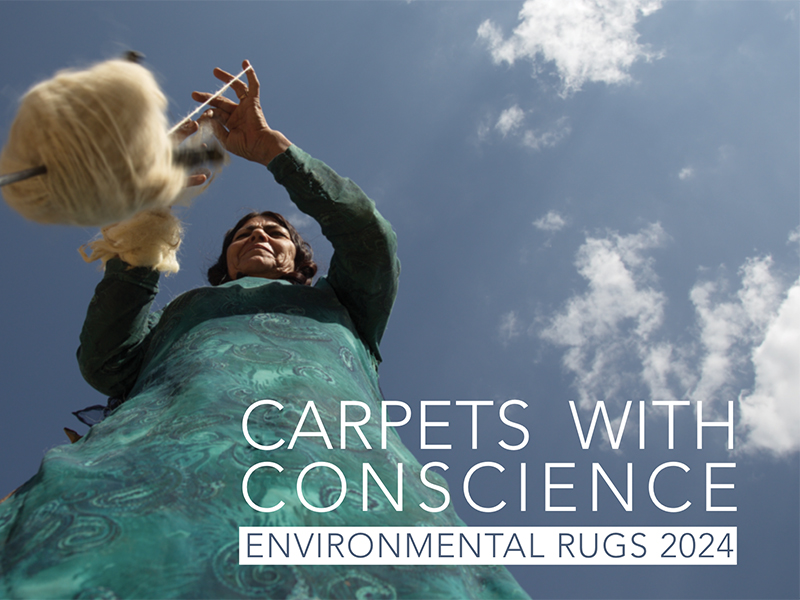We’ve been hearing about “green” products and practices for years now. With rugs and carpets, environmental awareness has evolved to encompass broad concerns. Today, they’re created with consideration for not only content and production, but also benefits to humanity.
Sustainable substances are essential: an environmentally-conscious rug is made of organic materials. For its new sustainable rug collections, Saddle Brook NJ-based Nourison Home has chosen 100-percent wool.
“It’s a natural material, and hand-tufted. Low-shed features contribute to longevity, reducing the need for frequent replacement,” explains Agnes Maczka, marketing specialist. Pure wool is “known for its durability and low environmental impact.”
In addition, wool’s natural properties slow bacterial growth, emit less airborne dust, and enrich soil. Its easily cleanable surface can muffle sound.
S&H Rugs Vintage and Persian Tabriz are made of organic and natural fibers, especially cotton and wool. “These will not harm the environment, even if thrown away,” notes Ori Wilbush, CEO of S&H Rugs in Carlstadt, NJ.
The Alpine collection, from Exquisite Rugs of Commerce CA, uses pure New Zealand wool, “which is biodegradable and renewable, with natural insulation properties. Its inherent qualities contribute to a luxurious texture while aligning with sustainability principles,” says Hersel Bani-Esraili, principal. “Because it’s hand-spun, these rugs are both soft and chunky, exuding comfort and eco-consciousness.”
“Tamarian rugs are truly sustainable, relying on natural materials gathered from sheep and the land, and traditional weaving techniques by skilled artisans,” says Ned Baker of Tamarian in Baltimore.
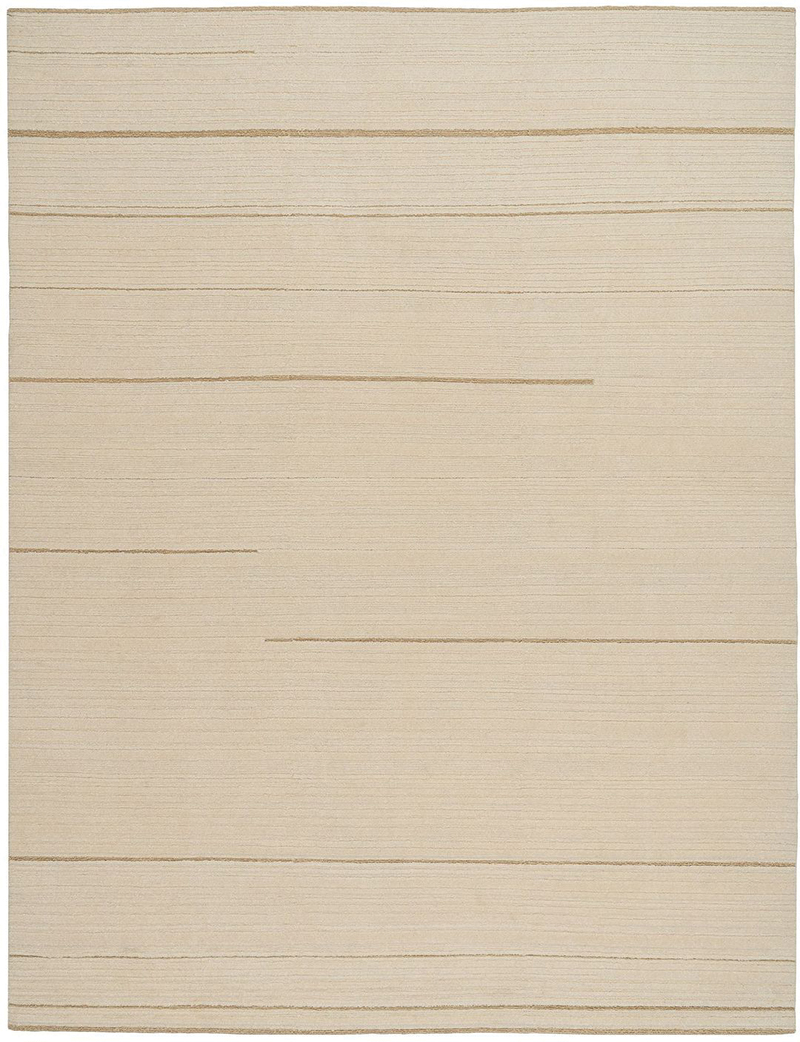
Tamarian’s Millhouse PW Cream
“Tamarian rugs, beyond their environmental value, provide sustenance to shepherds, farmers, weavers and their families—the makers and suppliers.“ NED BAKER, TAMARIAN
Since its 1947 founding, Zurich-based Zollanvari International has helped nomadic tribes by choosing Zagros Mountain wool, renowned for suppleness. “We use traditionally hand-spun and hand-carded wool, with highest-quality environmentally friendly vegetable dyes from plants collected in the immediate vicinity of the nomadic weavers. Our dyeing facility—run by a master dyer with knowledge and experience from many generations of a family dedicated to the art of dyeing—safeguards these skills for future generations,” explains Ramin Zollanvari.
Every rug from Armadillo, an Australian and American company, is hand-crafted of carefully-sourced materials including silk, linen, wool and jute. “We feel strongly about natural fibers, with their rich, tactile feel. They are a much healthier choice for your home, and the environment at large,” says co-founder Sally Pottharst.
Their new Petra collection, containing Armadillo’s first Berber-style rugs, is a modern take on a traditional Moroccan design. Hand-knotted of New Zealand wool, Petra’s braided-tassel edging on two ends introduces a second texture to the thick pile. Muted, nature-oriented color selections are Storm, Arctic, Cloud, Blanc and Sparrow. Their Staccato collection, an Indo-Nepali weave of lustrous silk, alternates hidden linen loops, in a staggered design pattern. Texture and color are juxtaposed.
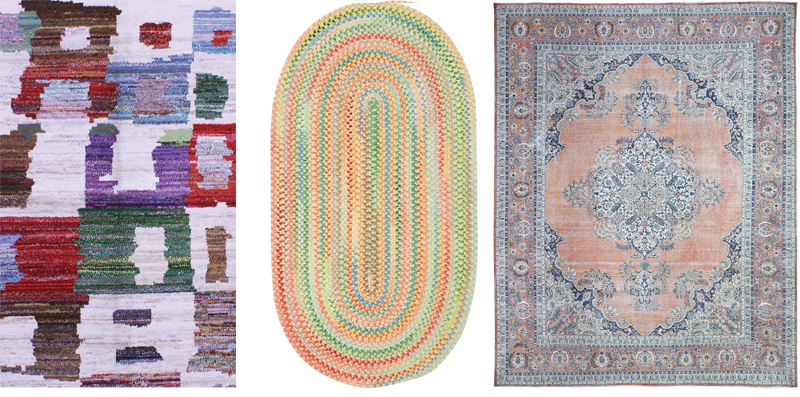
Left to right: Art Resources’ Rainbow collection #83697 in 100-percent wool; Capel’s all-cotton Buttercup design from its Cutting Garden collection; S&H Rugs color-reformed vintage Persian Tabriz #74483 in natural wool
Environmentally-Conscious Production
Thoughtfully-planned rug production can feature “green” approaches and concerns.
Operations at Armadillo’s six showrooms worldwide were verified as carbon neutral in 2023. “From our beginning (in 2009), we envisioned making a difference not just in the sanctuary of the home but in the wider world we live in,” explains co-founder Jodie Fried.
For its EcoAx collection, Creative Matters in Toronto avoids all synthetic materials or adhesives during construction. Besides pure wool, the rugs contain jute, a sustainable backing seamlessly woven into the fabric. “The robust product has comparable strength and longevity with our traditional woven Axminster rugs, made of 80-percent wool and 20-percent nylon,” reports Ana Cunningham, Managing Partner. The EcoAx palette offers eight natural, undyed shades.
Creative Matters emphasizes ethical production, responsible sourcing and fair labor practices. Their holistic approach “engages clients in early-stage planning, and promotes sustainable options such as diverting carpets from landfills. Creative Matters is a leader in environmentally conscious manufacturing practices,” says Cunningham.
In Nourison’s Graceful rug collection, “Handmade craftsmanship contributes to sustainability by supporting traditional techniques. This reduces the environmental impact associated with mass production,” Maczka observes.
Exquisite Rugs’ Alpine collection, says Bani-Esraili, “reflects a commitment to environmental responsibility, as its production minimizes ecological impact. Using renewable resources in its creation shows a dedication to sustainable practices.”
To Baker, “Tamarian rugs, beyond their environmental value, provide sustenance to shepherds, farmers, weavers and their families—the makers and suppliers.”
Zollanvari encourages diversity in weaving techniques, by reviving very old ones and developing new ones. “In our finishing plant, we constantly seek to reduce the consumption of water in the production process, to decrease effluents in water from dyestuffs and thus permit easier water recycling,” says Zollanvari.
“Zollanvari’s concept of resource-efficient, sustainable production is deep-rooted. At every stage of creating tribal carpets, rugs and kilims, we endeavor to preserve the delicate balance between the local environment and the weaving region economy: the nomads of Iran’s Zagros Mountains area and their social identity, while regarding the nomads’ traditional way of life.”
Repurposing rugs “moves us closer to our goal of sustainability,” notes Wilbush. “With used or old Persian rugs, when someone wants to re-use them, it’s impossible, because of the bright red and blue jewel tones.“ For re-use, the careful S&H process will, “color-reform these vintage pieces through multiple washings, with various herbs and teas. Then, we sun-dry and clip down to attain desirable colors for today’s needs and uses.”
Setting a priority on transparency, Armadillo recently published its first Impact Report, outlining “in full our commitments to people and planet. Our goals are ambitious by design, intended to instigate lasting change not only within our business but, we hope, with a ripple effect on our wider industry,” says Pottharst.
Armadillo partners with the International Living Future Institute. Every rug bears a Declare label that shows all contents; where it was made; life expectancy; and other details. The easily understandable Declare label reflects Armadillo’s leadership in protecting human and environmental health.
“Organic and natural fibers, especially cotton and wool… will not harm the environment, even if thrown away.“ ORI WILBUSH, S&H RUGS
INTERNATIONAL RECOGNITION
At Domotex, the rug industry’s global trade fair, the 2024 theme was “Floored by Nature.” Special displays at the four-day January event in Germany featured sustainable materials and environmentally friendly products.
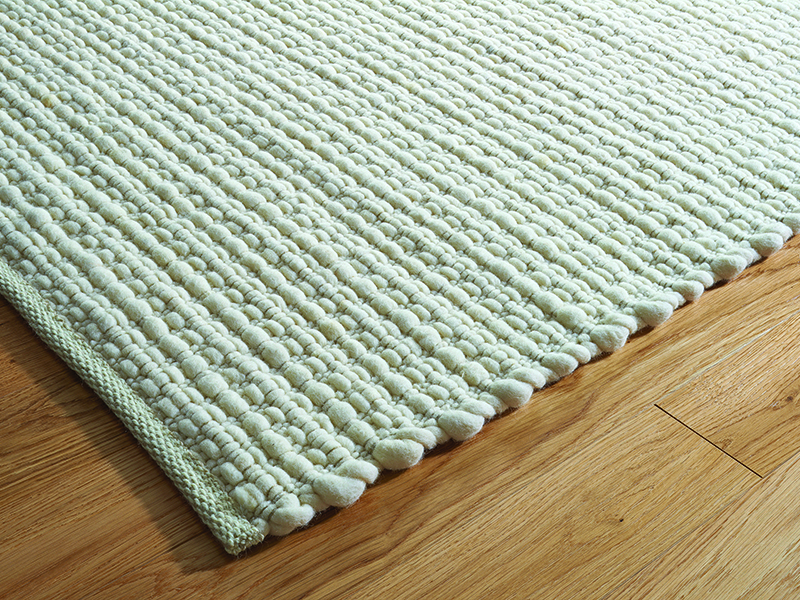
Fortuna from the Olbia Pure Nature collection from Tisca Rugs by LSI.
The Olbia Pure Nature collection from Tisca Rugs by LSI won the prestigious Domotex Green Collection Award. The jury cited the collection’s “traditional, artisanal craftsmanship and the beauty of the sheep wool’s natural color, as well as its certification for Global Organic Textile Standards.” GOTS certification verifies Tisca Rugs’ commitment to sustainable practices through- out the entire textile supply chain.
An international association established in 2002, GOTS supports organic production methods. They strongly protect the organic status of textiles, from raw material harvesting to environmental manufacturing. A GOTS label assures the consumer that the product contains at least 70-percent certified organic fibers, “processed with the least possible environmental impact, under strict controls on natural and synthetic chemical inputs and respect for labor conditions.”
“Environmental responsibility permeates every aspect of our companies, which helped the Tisca Group and LSI become internationally renowned leaders in sustainability.“ LARRY LANE, LSI FLOORING
“Our Olbia collection is made entirely of natural fiber: 100-percent New Zealand wool and cotton warp/weft yarns,” says Larry Lane, executive director of Tisca, North America and president of LSI Flooring. “Environmental responsibility permeates every aspect of our companies, which helped the Tisca Group and LSI become internationally renowned leaders in sustainability.” (LSI Flooring has represented Austria-based Tisca in North America since 2012.)
The Olbia collection—26 styles and structures, 96 colors, and rug sizes up to 19'7" wide—reflects Tisca’s priorities. “Many companies loosely say ‘natural’ or ‘sustainable’ about their products. For us, it’s factual,” Lane affirms. “This award means so much because it cites our actual accomplishments in sustainability, not just a marketing tagline. More importantly, the Domotex award recognizes us not only for the products but for our sustainable production processes as well. That is such an important distinction.”
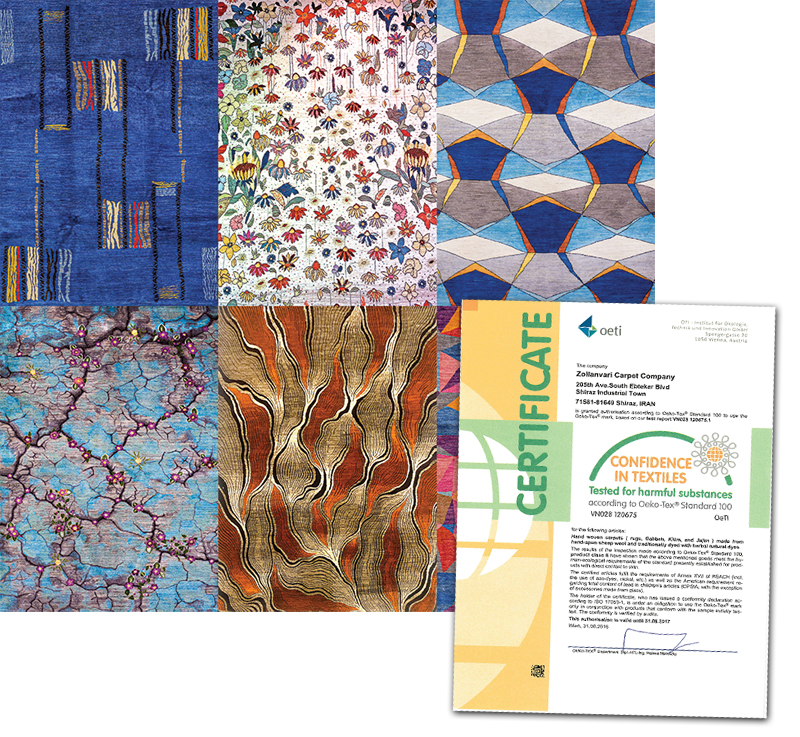
Zollanvari is one of the only handmade carpet manufacturers to be awarded the OEKO-TEX® Standard 100 Certificate for handwoven carpets made from hand-spun sheep wool and traditionally dyed with herbal natural dyes. Left: A composite of the company’s designs.
Zollanvari International is one of few handmade carpet manufacturers to receive the OEKO-TEX Standard Certificate, verifying that their products are free from 1,000 harmful substances.
“We continue to push the boundaries in weaving the finest tribal carpets with deep regard for the pillars of sustainability.“ RAMIN ZOLLANVARI, ZOLLANVARI
CONSUMER CONCERNS
“Organic textiles will become significant in everyday life, enhancing people’s lives and the environment,” GOTS anticipates. Which environmental factors are likely to concern consumers?
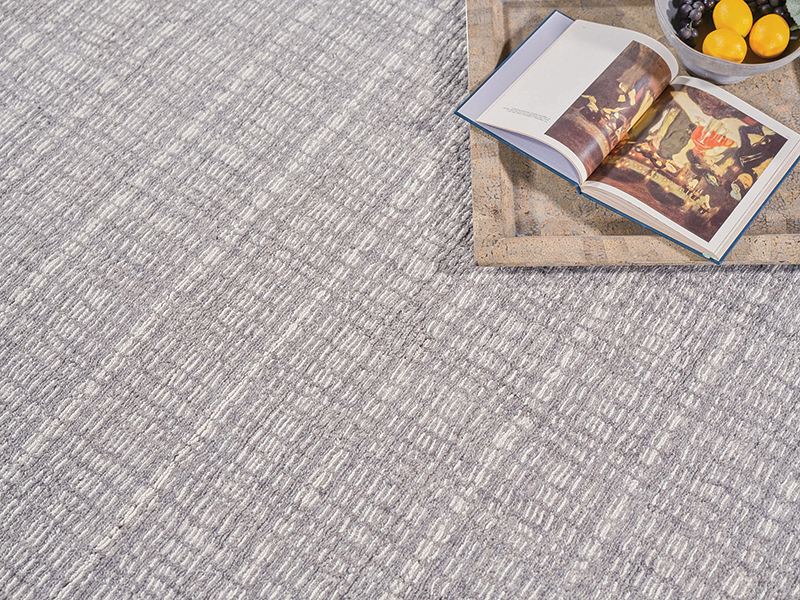
Exquisite Rugs' Alpine collection, design #5984 shown above uses pure hand-spun New Zealand wool.
A selection from Exquisite Rugs’ Alpine collection will “not only elevate any space aesthetically, but also resonate with mindful choice. It fosters a connection between comfort, style, and environmental consciousness,” says Bani-Esraili.
“We’ve designed our Haring and Millhouse rugs with natural tones and varied textures, to harmonize with many interiors,” notes Daisy Barquist of Tamarian. “As a quality heirloom, a Tamarian rug reduces waste, unlike many rugs that languish in warehouses, or those that were cast off too soon by homeowners. We encourage customers to engage with the rug physically: to touch it, smell it, look at it from all sides and angles. The beauty and quality of each rug will be evident to both hand and eye, as something of lasting value.”
Nourison’s Graceful collection will attract consumers, “for its unique blend of abstract design, high-low construction, and hand-carved finishing,” predicts Maczka. “Using 100-percent wool adds a natural and sustainable element, appealing to environmentally-conscious consumers. Hypoallergenic and durable features further enhance these rugs’ attractiveness to those looking for eco-friendly options.”
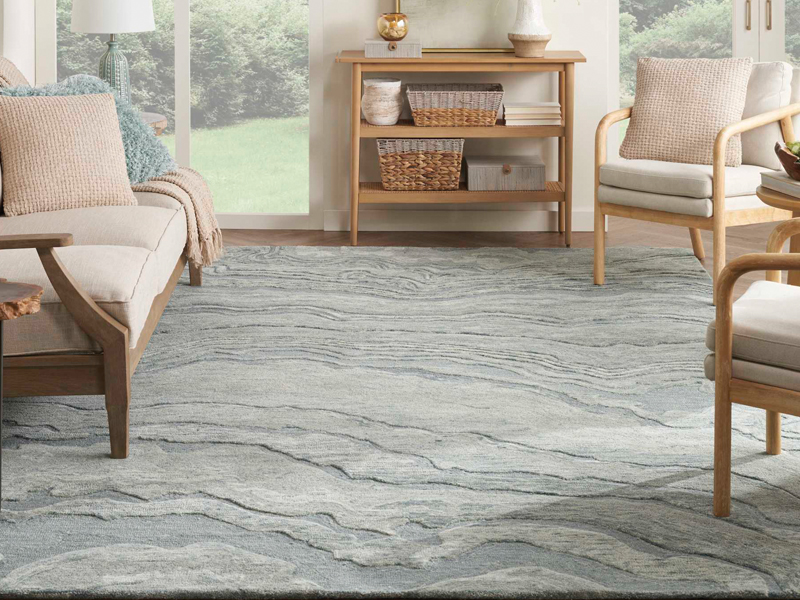
GRU01 Blue is from Nourison’s Graceful collection
“Retailers may communicate the timeless design that ensures these rugs remain stylish for years, promoting sustainability through longevity. Our Colorado collection’s versatile nature, suitable for various decors, makes these rugs appeal to a broad consumer base seeking both style and sustainability,” says Maczka. “Durable, low-shed wool fibers allow for easy care and casual style. They’re suitable for a range of decors from sophisticated urban lofts to modern farmhouses.” The earth-tones palette subtly reinforces the “green” qualities. The Graceful collection—also utilizing renewable, biodegradable pure wool—will appeal to consumers seeking healthier choices.
Consumers will appreciate EcoAx’s 100-percent biodegradable composition, says Cunningham. “This distinguishes it from traditional carpets, by showcasing a minimal ecological footprint. The glue-free, stretch-and-tack installation method we recommend will eliminate excessive adhesives, enhancing recyclability and compostability.”
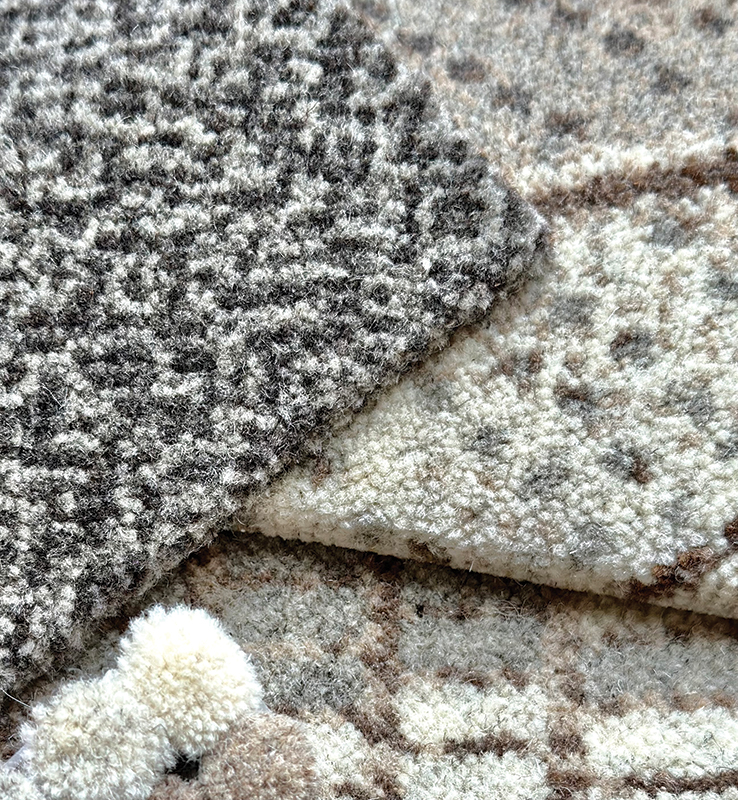
Creative Matters’ 100-percent biodegradable, environmentally-friendly EcoAx collection is a high-quality, enduring flooring option.
The EcoAx collection “provides an environmentally-friendly solution that enriches the soil during the process. Despite its sustainability, EcoAx is a high-quality, enduring flooring option,” Cunningham adds.
Zollanvari encourages its weavers to allow “their own aesthetic sense and artistic individuality in the designs. This sustains the creative process of this cherished art form. We continue to push the boundaries in weaving the finest tribal carpets with deep regard for the pillars of sustainability,” confirms Zollanvari. “For us, the art of carpet-making exemplifies the expression of a culture and a way of life.”
Armadillo strives to keep ancient rug-making skills alive, while celebrating the beauty of the handmade. “For us, it always comes back to craftsmanship. Quality is an extension of sustainability—if you consider wisely and invest in something with longevity, you will need to replace it less frequently, if at all,” affirms Fried.
“In the design world, luxury is often the ultimate aspiration. To us, true luxury is leaving the world better than we found it,” she reflects.
IMAGES COURTESY OF THEIR RESPECTIVE COMPANIES
